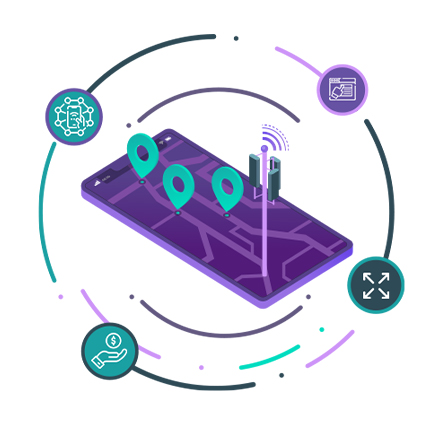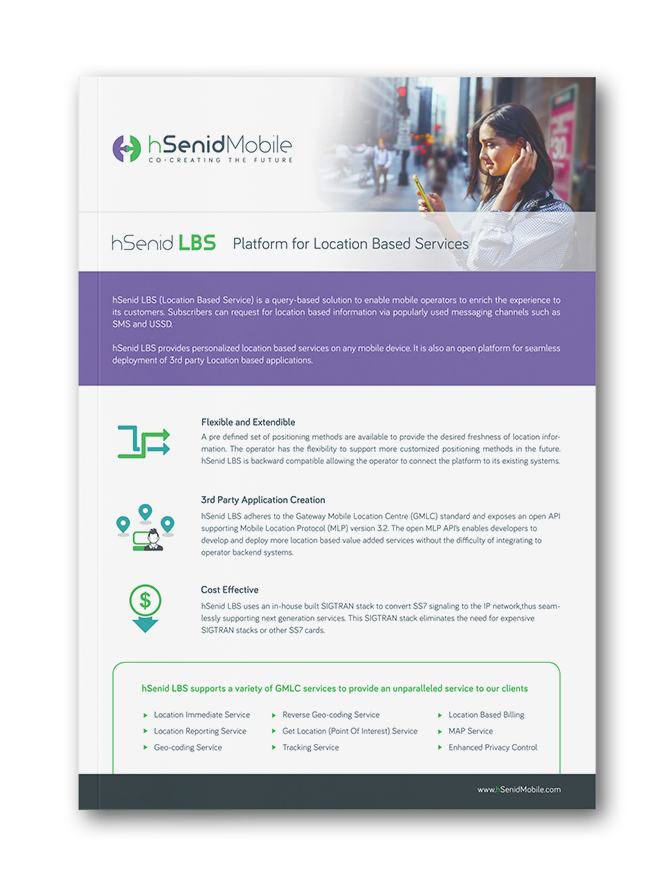In a world where climate disasters, protests, and health problems can happen
anytime, it’s more important than ever to quickly let the right people know
what’s going on. LBS for emergency alerts via SMS provides telecom operators
with a powerful, location-targeted communication tool that can save lives and
enhance public safety. Unlike email or app-based notifications, SMS ensures
reach even when internet connectivity is unavailable — a common scenario
during disasters.
Telecom providers play a central role in enabling this life-saving capability. As regulatory bodies and governments continue to mandate real-time alert systems, Location-Based Services (LBS) via SMS are emerging as a mandatory infrastructure investment for telcos. Let’s explore why LBS matters, how it works, its benefits, and how telcos can deploy it effectively.
Location-Based Services (LBS) enable mobile operators to determine a user’s real-time geographical position using various methods, including cell ID, triangulation, and hybrid GPS systems. LBS for emergency alerts via SMS harnesses this data to broadcast alerts only to users within a predefined geographic boundary.
For instance, if a wildfire breaks out in a rural province, telcos can geo-fence the impacted zone and push immediate evacuation instructions via SMS to all devices in that area.
The fundamental advantage of this approach lies in its precision — sending messages only to those who need them, without overwhelming the rest of the population.
Here are some powerful examples where LBS for emergency SMS has proven invaluable:
Nearly 6.8 billion SMS messages are sent daily worldwide, highlighting the enduring power of this channel.
For telcos, integrating LBS into their emergency infrastructure offers:
While the promise of LBS is compelling, telcos must navigate:
For telecoms seeking a proven, scalable solution, hSenid Mobile offers a powerful LBS platform purpose-built for emergency alerting:
LBS for emergency alerts via SMS is not just a compliance requirement, it is a mission-critical capability that reflects a telecom provider’s commitment to national safety and customer well-being. As climate change and geopolitical risks escalate, telcos that invest in robust, real-time alerting will lead not only in technology but in public trust. Partner with hSenid Mobile to implement a future-ready, carrier-grade LBS platform that empowers you to deliver lifesaving messages when they matter most. Learn more or book a demo at www.hsenidmobile.com
Telecom providers play a central role in enabling this life-saving capability. As regulatory bodies and governments continue to mandate real-time alert systems, Location-Based Services (LBS) via SMS are emerging as a mandatory infrastructure investment for telcos. Let’s explore why LBS matters, how it works, its benefits, and how telcos can deploy it effectively.
What is LBS for Emergency Alerts via SMS?
Location-Based Services (LBS) enable mobile operators to determine a user’s real-time geographical position using various methods, including cell ID, triangulation, and hybrid GPS systems. LBS for emergency alerts via SMS harnesses this data to broadcast alerts only to users within a predefined geographic boundary.
For instance, if a wildfire breaks out in a rural province, telcos can geo-fence the impacted zone and push immediate evacuation instructions via SMS to all devices in that area.
The fundamental advantage of this approach lies in its precision — sending messages only to those who need them, without overwhelming the rest of the population.
Why SMS and LBS Are the Ideal Pairing for Emergencies
- High Penetration and Read Rate: Unlike apps or emails, SMS reaches over 90% of mobile users globally, even those using basic phones. SMS also has an unmatched 98% open rate, with most messages read within 3 minutes of delivery. This immediacy is crucial during natural disasters or terror threats.
- Works Without Internet: Emergencies often knock out the internet infrastructure. SMS, riding on telco signalling networks (SS7 or SIGTRAN), continues to function even when 3G, 4G, or Wi-Fi goes down.
- Real-Time, Geo-Fenced Reach: By using LBS, telecom operators can send targeted alerts to all mobile devices within a specific geographical area, down to the city block. This ensures public safety messages are hyper-relevant and efficient.
- Regulatory Compliance: Governments in regions like the EU (via EU-Alert), the US (via WEA), and Asia-Pacific are increasingly making it mandatory for mobile operators to support location-based alerting systems.
Use Cases in Real Life
Here are some powerful examples where LBS for emergency SMS has proven invaluable:
- Japan’s Earthquake Alerts: Using cell broadcast and SMS with LBS, residents received evacuation instructions seconds after seismic activity.
- Sri Lanka’s Flood Management: During monsoon seasons, telecoms delivered warnings to at-risk citizens in affected districts.
- European Union Alert System: Operators are mandated to provide LBS-based emergency alerting services under Article 110 of the European Electronic Communications Code (EECC).
Why Telcos Should Act Now
Nearly 6.8 billion SMS messages are sent daily worldwide, highlighting the enduring power of this channel.
For telcos, integrating LBS into their emergency infrastructure offers:
- New Revenue Streams: Governments are willing to pay for resilient emergency delivery infrastructure.
- Brand Trust: Operators that prioritize safety see a spike in customer loyalty.
- Regulatory Edge: Proactive deployment prepares telcos for fast compliance with changing legal mandates.
Challenges and Considerations
While the promise of LBS is compelling, telcos must navigate:
- Data Privacy: Location data must be handled in compliance with local data protection laws.
- Network Load: Systems must scale to handle sudden spikes during crisis events.
- User Device Compatibility: Alerts must reach both smart and feature phones.
Why hSenid LBS is the Right Choice
For telecoms seeking a proven, scalable solution, hSenid Mobile offers a powerful LBS platform purpose-built for emergency alerting:
- Supports SIGTRAN, MLP, ATI, and PSI protocols for diverse deployment environments
- Admin console for real-time alert creation and visualization
- Modular design allowing integration with charging gateways, third-party apps, and national disaster management systems
- Flexible positioning methods to suit urban and rural network dynamics
Final Thoughts
LBS for emergency alerts via SMS is not just a compliance requirement, it is a mission-critical capability that reflects a telecom provider’s commitment to national safety and customer well-being. As climate change and geopolitical risks escalate, telcos that invest in robust, real-time alerting will lead not only in technology but in public trust. Partner with hSenid Mobile to implement a future-ready, carrier-grade LBS platform that empowers you to deliver lifesaving messages when they matter most. Learn more or book a demo at www.hsenidmobile.com








